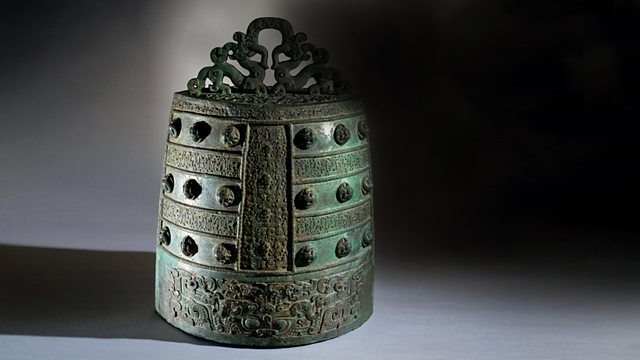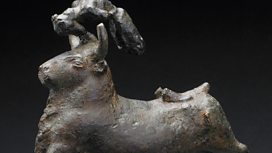Chinese Bronze Bell
Neil MacGregor's history of the world through objects at the British Museum summons up the sound of China 2,500 years ago, with a bronze bell from the age of Confucius
This week Neil MacGregor is exploring the emergence of sophisticated new powers across the world 2500 years ago, from the Parthenon in Greece, to the great empire of Cyrus in Persia and the forgotten people of the Olmec in Mexico.
Today he arrives in China at the time of Confucius. He explores the Confucian view of the world with a large bronze bell - with help from the writer Isabel Hilton and the percussionist Evelyn Glennie. Confucius believed in a society that worked in harmony. How do his teachings go down in China today?
Last on
More episodes
Next
You are at the last episode
![]()
More programmes from A History of the World in 100 Objects about sport and entertainment
About this object
Location: Shanxi province, China
Culture: Ancient and Imperial China
Period: About 500-400 BC
Material: Metal
听
This bronze bell is known as a bo. It is decorated with dragons swallowing geese and has a handle in the shape of two dragons. It required great skill to make a bo and bells of similar size were not made in the west until a thousand years later. This bo would have been part of a set of bells of different sizes each playing different notes. It is played with a hammer and plays two different notes depending on where it is struck.
How was harmony created through music in ancient China?
This bell was made at the beginning of the Warring States period - a time of political fragmentation and moral crisis in China. It was in this turmoil that the Chinese political philosopher Confucius developed his philosophy. Confucius had one overwhelming message: if we are to achieve a state of orderliness and peace, we need to return to traditional values of virtue. Confucius was also a keen musician and saw in music the harmony he wanted to achieve in society.
Did you know?
- A set of bronze bells like this one was played during the ceremony to pass Hong Kong from British to Chinese rule.
Playing an important role in China
By Carol Michaelson, Curator, British Museum
听
Bells were used in ancient Chinese rituals to communicate with ancestral spirits, to sound the retreat in battles and also for entertainment as ensemble instruments in concert with other instruments, singers and dancers.
Ancient Chinese bells are not circular but have rather an almond-shaped cross-section. This is important because it means the sound dies away quickly and does not interfere with any following music. It gives a well-focused pitch and is rather more musical than the sound of a circular bell.
Chinese bells have no clappers, so they make their sounds by being struck with wooden sticks. Their shape gives them two distinct pitches, depending on whereabouts on them they are struck.
In southern China, in Hunan and Jiangxi provinces, very large bells have been excavated (dating to the Zhou dynasty, about 1050-221 BC), which are heavier than tuned bells and seemed to have been played as a single unit. The tones are more striking and lack the harmonies of the tuned bells which indicate that they were used as untuned, ritual instruments, rather than to create melodies.
The most famous Chinese bell set in the world was found in the tomb of the Marquis of Yi from one of the warring states of China (475-221 BC) called Zeng. The Marquis obviously loved music and was buried with many musical instruments including zithers (a stringed instrument), drums, flutes, pan pipes and chimes. To play the instruments for him, 22 servants were killed to accompany the Marquis to the afterlife.
The bell set consists of 65 tuned bells and covers a range of five octaves. They weigh a total of around 4,521kg and are inscribed with over 3,700 Chinese characters telling us (amongst other things) the two tones each bell can play.
The bells can still be played and were used by the contemporary composer Tan Dun when he was asked to compose music to commemorate the transfer of Hong Kong to China in 1997.
Even today, most Buddhist and Daoist temples are furnished with bells which are beaten as part of the religious ceremonies.
Transcript
Broadcasts
- Fri 26 Feb 2010 09:45主播大秀 Radio 4 FM
- Fri 26 Feb 2010 19:45主播大秀 Radio 4
- Sat 27 Feb 2010 00:30主播大秀 Radio 4
- Fri 28 Aug 2020 13:45主播大秀 Radio 4
Featured in...
![]()
Sport and Entertainment—A History of the World in 100 Objects
A History of the World in 100 Objects - objects relating to sport and entertainment.
Podcast
-
![]()
A History of the World in 100 Objects
Director of the British Museum, Neil MacGregor, retells humanity's history through objects





